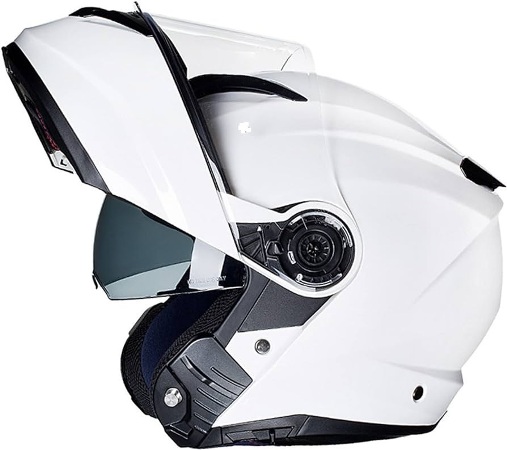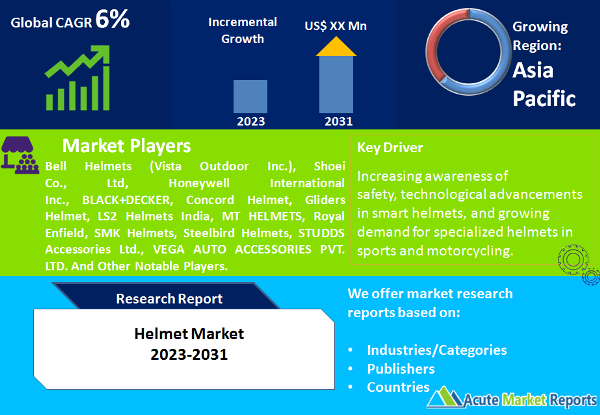
The helmet market plays a pivotal role in ensuring safety and protection across various domains, including sports, motorcycle riding, and general safety applications. During the forecast period of 2025 to 2033, this market is poised for steady growth with an expected CAGR of 6%, driven by factors such as increasing awareness of safety, technological advancements in smart helmets, and growing demand for specialized helmets in sports and motorcycling. In conclusion, the helmet market is set for substantial growth from 2025 to 2033, driven by increasing safety awareness, technological advancements in smart helmets, and the demand for specialized helmets across various sectors. Despite cost constraints posing a restraint, the market's overall outlook is promising, with specific product segments, regions, and key players contributing to its trajectory.

Increasing Awareness of Safety: The rising awareness of safety, particularly in sports and transportation, is a major driver of the helmet market. With a growing emphasis on personal safety, individuals are increasingly recognizing the importance of wearing helmets to reduce the risk of head injuries. This awareness has led to a surge in demand for helmets across various sectors, including sports, motorcycling, and workplace safety. In 2024, this trend resulted in substantial growth in the market, with sports and motorcycle helmets leading the way. This demand for safety is expected to continue driving market growth from 2025 to 2033, with the Sports and Moto segments poised for significant expansion.
Technological Advancements in Smart helmets: Technological advancements in smart helmets are a significant driver of the helmet market. Smart helmets integrate advanced technologies such as built-in communication systems, heads-up displays, and impact sensors to enhance safety and provide additional features. In recent years, the development of smart helmets has gained momentum, catering to the demands of tech-savvy consumers who seek not only protection but also connectivity and convenience. In 2024, the market witnessed a surge in demand for smart helmets, reflecting the growing interest in these high-tech safety solutions. Looking ahead to 2025 to 2033, the Smart helmet segment is projected to exhibit the highest compound annual growth rate (CAGR) within the market, as consumers increasingly opt for helmets with added functionality and connectivity.
Growing Demand for Specialized helmets: The growing demand for specialized helmets is a notable driver of the helmet market. Different activities and industries require helmets tailored to their specific needs. For example, sports enthusiasts seek helmets designed for optimal performance and protection, while motorcyclists require helmets that meet safety standards for road use. Workplace safety regulations also drive the demand for specialized helmets in industries such as construction and manufacturing. In 2024, this demand for specialized helmets contributed to the market's growth, with the Sports and Moto segments leading in revenue. This trend is expected to continue from 2025 to 2033, with specialized helmets playing a crucial role in meeting safety standards and consumer preferences.
Restraint - Cost Constraints: Despite the promising growth prospects, the helmet market faces a restraint in the form of cost constraints. High-quality helmets, especially those equipped with advanced features, can be relatively expensive. This cost factor can deter potential buyers, particularly in regions with lower income levels. Additionally, cost constraints can pose challenges for manufacturers aiming to produce affordable helmets while maintaining quality and safety standards. Market players must address this restraint by exploring cost-effective manufacturing methods, materials, and technologies to make helmets more accessible to a wider range of consumers without compromising safety.
Market Segmentation by Product (Sports, Moto, Safety Generic): Sports helmet Dominate the Market
The helmet market offers a diverse range of products, each designed to cater to specific safety needs and activities.
Market Segmentation by Category (Conventional helmet, Smart helmet): Conventional helmets Dominate the Market
The helmet market includes different categories of helmets, each offering distinct features and benefits.
APAC to Present Significant Opportunities during the Forecast Period
The helmet market demonstrates regional variations in trends, growth rates, and revenue distribution across different geographical areas. Asia-Pacific is expected to showcase the highest CAGR during the forecast period from 2025 to 2033, driven by the increasing adoption of safety measures in developing economies. North America is anticipated to retain its position as the region with the highest revenue percentage, reflecting a strong culture of safety and motorcycling in the region. Europe and Latin America are also expected to experience steady growth, as safety awareness and regulatory compliance remain paramount.
Market Competition to Intensify during the Forecast Period
The helmet market is characterized by intense competition among key players, with several leading companies driving innovation and market growth. In 2024, these companies reported significant revenues and their strategies are expected to continue shaping the market from 2025 to 2033.
Historical & Forecast Period
This study report represents analysis of each segment from 2023 to 2033 considering 2024 as the base year. Compounded Annual Growth Rate (CAGR) for each of the respective segments estimated for the forecast period of 2025 to 2033.
The current report comprises of quantitative market estimations for each micro market for every geographical region and qualitative market analysis such as micro and macro environment analysis, market trends, competitive intelligence, segment analysis, porters five force model, top winning strategies, top investment markets, emerging trends and technological analysis, case studies, strategic conclusions and recommendations and other key market insights.
Research Methodology
The complete research study was conducted in three phases, namely: secondary research, primary research, and expert panel review. key data point that enables the estimation of Helmet market are as follows:
Market forecast was performed through proprietary software that analyzes various qualitative and quantitative factors. Growth rate and CAGR were estimated through intensive secondary and primary research. Data triangulation across various data points provides accuracy across various analyzed market segments in the report. Application of both top down and bottom-up approach for validation of market estimation assures logical, methodical and mathematical consistency of the quantitative data.
| ATTRIBUTE | DETAILS |
|---|---|
| Research Period | 2023-2033 |
| Base Year | 2024 |
| Forecast Period | 2025-2033 |
| Historical Year | 2023 |
| Unit | USD Million |
| Segmentation | |
Product
| |
Category
| |
Design
| |
Gender
| |
Price
| |
Distribution Channel
| |
|
Region Segment (2023-2033; US$ Million)
|
Key questions answered in this report